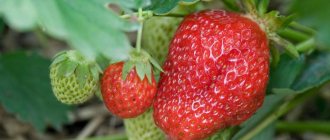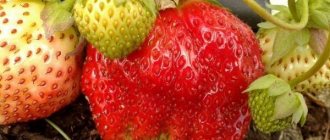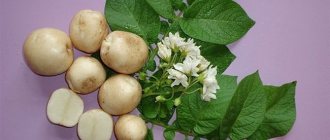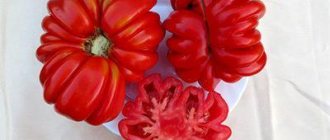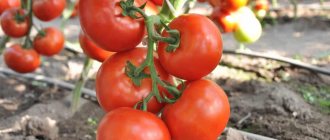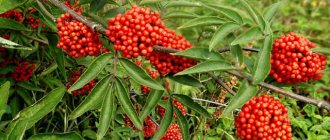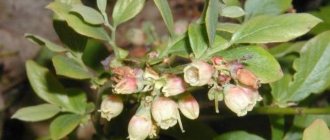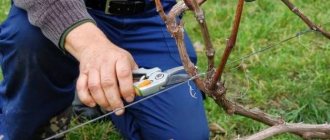"Good faith" fallacy
Perhaps there are lucky ones who managed to get seedlings obtained from seeds treated with mutagens.
There is indeed information about such planting material, but there is no guarantee that it is exactly what is being offered to you. Most often, gardeners are mistaken about the self-fertility of their sea buckthorn, without even realizing the mistake. How and why does this happen?
Relatives of vitamin culture
Residents of the Ural region, Siberia, and Altai are unlikely to confuse sea buckthorn with some other berry crop, but in places remote from the shrub’s natural habitat, its close relatives may be mistaken for self-pollinating varieties.
Shepherdia silver is sometimes called red sea buckthorn. The plant is quite heat-loving, so it is more often found in the south of Russia and Ukraine. Shrubs have a lot in common:
- belonging to the same Sucker family;
- oblong silvery foliage;
- small orange-red drupes collected in dense cobs;
- sour taste of berries.
Shepherdia, by the way, is also a dioecious plant. But if you mistake it for sea buckthorn, you may not know that there is a pollinator growing somewhere nearby.
Another relative of our heroine is the angustifolia sucker. A person who is far from gardening may mistake it for a variety of self-pollinating sea buckthorn, since the plants are similar with whorled silver leaves, prickly shoots and clusters of yellow-brown berries. Loch is a truly self-fertile plant.
Grafted plants
Some gardeners, instead of planting a pollinator separately, graft several of its branches into the crown of the female plant. This is convenient for many reasons.
- The barren shrub does not take up space in the garden.
- If a branch dries out, you can graft another one instead of looking for a new seedling.
- Unlike male specimens, a grafted female plant produces much less growth.
Having bought a seedling of already grafted sea buckthorn, and without specifying why a pollinator is not needed, inexperienced gardeners perceive it as a self-pollinating variety. But if you look closely at the bush in the spring, you will see that the buds on the male branches are 2–3 times larger, and the flowers are different.
Cases of fruiting of “male” shrubs
Sometimes you can observe how single fruits are set on male specimens of the crop. Some scientists consider this evidence that the plant was originally a “hermaphrodite” and the separation of the sexes occurred later. By experimenting with such material, they are trying to develop self-fertile varieties. But more often the fruiting of “boys” is the result of a genetic mutation caused by chemicals.
If we exclude the factor of confusion, we can only assume that you are growing a truly self-fertile variety of sea buckthorn, which acquired its unusual characteristics as a result of a natural or artificial mutation.
Elizaveta – sea buckthorn plant variety
Variety characteristics:
Properties of the Elizabeth variety:
Recommended region on the map:
Information on the admission of Sea Buckthorn Elizaveta from the Register of the State Variety Commission of the Russian Federation
Application for admission No. 30117, registered 1997-01-18. The Sea Buckthorn variety Elizaveta was included in the register of those approved in 2006. Approved for use in the regions: Ural, West Siberian, East Siberian.
The originator of the Sea Buckthorn Elizaveta variety is:
- FEDERAL ALTAI RESEARCH CENTER OF AGROBIOTECHNOLOGY (656910, BARNAUL-51, SCIENTIFIC TOWN, 35)
Information about the patent for the variety Sea Buckthorn Elizaveta
Patent holder of the Elizabeth variety:
- FEDERAL ALTAI RESEARCH CENTER OF AGROBIOTECHNOLOGY (656910, BARNAUL-51, SCIENTIFIC TOWN, 35)
Application for protection of the Elizaveta variety No. 35241, registered 1997-01-18.
Patent No. 1347, registered 2002-04-12. Estimated patent expiration date 2032-12-31.
Authors of the variety Sea Buckthorn Elizaveta
- Panteleeva Elizaveta Ivanovna
- Pletneva Tamara Mikhailovna
Other varieties of sea buckthorn plants
Search for variety by name
Landing rules
Growing sea buckthorn Elizabeth has its own characteristics. The choice of place and timing of planting, as well as careful selection of seedlings, plays an important role in the further growth and development of the berry crop.
Recommended timing
Sea buckthorn is planted in spring or autumn. In the first case, it is necessary to add organic fertilizers to the soil, and then provide the plant with proper care. If planting is done in the fall, then you should make sure the integrity of the root system. The seedling needs to be covered with dense material until spring.
Choosing a suitable location
The optimal place for planting seedlings is the southern, sunny side of the site. Many reviews of Elizabeth sea buckthorn contain information that the crop prefers sandy soils with a neutral or alkaline pH.
Therefore, it is worth choosing areas near fences or small buildings.
Soil preparation
Preparing a hole for planting a sea buckthorn seedling is carried out in about a month (if planting is planned in the fall), or six months in advance (if in the spring). It is necessary to dig a hole with a diameter and depth of 50 cm. Then prepare and pour into the hole a substrate from a mixture of humus and sand with a small addition of ash.
Selection and preparation of seedlings
When buying seedlings, pay attention to the planting material. The seedling should not have any damage and the root system should be healthy
To get a rich harvest, you need to purchase two seedlings at once: male and female. They differ in the shape of the buds and the number of scales. On a female plant, the buds have an elongated shape and a maximum of 3 scales, and on a male plant, the buds are rounded with up to 7 scales.
Algorithm and landing scheme
Planting sea buckthorn Elizabeth is carried out in several stages:
- Preparing the pit and soil.
- Installing the seedling in the center of the hole and straightening the root system.
- Adding substrate to the pit.
- Compacting the soil.
- Watering the soil and mulching it with sawdust and peat.
For stability, the seedling is tied to a peg.
Botanical description of the plant
Sea buckthorn Elizabeth is a medium-sized shrub, the height of which, according to the description, rarely reaches 5 m, making the plant ideal for small garden plots. The multi-stemmed “structure” of sea buckthorn forms a spherical crown, but by pruning it can be given the appearance of a tree with a neat oval shape. At the tops of the shoots, the leaves are dark green, elongated, and closer to the bottom they acquire an olive tone with a light silvery coating on the back side.
Aerial part: 1 - root collar; 2 - trunk; 3 — branch of the first order of branching; 4 — branch of the second order of branching; 5 - branch of the third order of branching (fruit-bearing branch); 6 — branch of the fourth order of branching (growth of the current year). The shoots have practically no thorny shoots, so it is easy to collect fruits from them. The bush begins to bear fruit in the 4th year, and the berries ripen by the end of August. With good care, you can achieve high yields - up to 15 kg of fruits per plant. At the same time, sea buckthorn berries are large, juicy, up to 1 cm long and weighing up to 1.1 g, have a pleasant dessert taste and a bright orange color. When growing berry bushes, many rely on their beneficial properties.
So, sea buckthorn Elizabeth is a plant that can be fully considered medicinal. Its fruits and leaves contain a large complex of vitamins, with the most ascorbic acid (vitamin C) - about 100 mg per 100 g of berries. The chemical composition also contains micro- and macroelements (calcium, magnesium, potassium, etc.), phospholipids that restore cellular tissue, fatty acids that stimulate brain function, gastrointestinal tract, and many other useful substances.
The best varieties of sea buckthorn - photos, descriptions
Sea buckthorn is a necessary plant for your dacha. The healing effect of sea buckthorn fruits is very high. They contain a whole complex of vitamins, microelements, potassium salts, sodium, calcium, sugar, organic acids, pectins, tannins, fatty oil.
Sea buckthorn oil and preparations with its additives are widely used in medicine and perfumery.
The preparations retain the properties, taste and aroma of fresh fruits, which is very important
But many summer residents are stopped by the fact that it is oh so difficult to collect sea buckthorn because of its thorns... Let's talk about modern varieties that will greatly facilitate this task.
Sea buckthorn varieties without thorns
EXCELLENT Sea buckthorn of this variety has no thorns at all! And besides, it tastes like dessert. Yellow-orange fruits weighing up to 0.8 g, beautiful cylindrical shape with juicy pulp and delicate aroma. When collected, they are practically not damaged and are stored well. The variety is winter-hardy and frost-resistant. |
| FAVORITE Plants are medium-sized with a spreading sparse crown. The shoots are thick, practically without thorns. The fruits are large, weighing up to 0.8 g, cylindrical, bright yellow on a long stalk with a dry detachment. The taste is pleasant, this sea buckthorn can be eaten directly from the branches. |
PODRUGA Mid-season variety for universal use. Plants are medium-sized. The shoots are straight, thin, mostly without thorns or with very sparse ones. The leaves are light green, shiny, pubescent. The fruits are orange, weighing about 0.8 g, round-oval, skin of medium thickness. The taste is refreshing, sweet and sour. |
AMBER Plants are medium-sized with a rounded crown of medium density. The branches are almost without thorns. The fruits are orange, cylindrical, weighing up to 0.7 g, sweet and sour, mainly for processing. |
BOTANICAL AMATEUR One of the early varieties, the fruits ripen by mid-August. Bushes up to 4 m high. There are very few thorns. The fruits are oval, yellow-orange, about 0.7 g, juicy and tasty, but they ripen quickly and do not last long. |
Dessert varieties
| ELIZAVETA Winter-hardy, productive, late-ripening variety resistant to pests and diseases. The bush is compact, low-growing. The thorniness is weak. The fruits are orange, cylindrical, weighing about 0.8 g. The taste is dessert, sweet and sour with a pronounced aroma. |
RUET One of the most delicious varieties of early ripening sea buckthorn. Plants are medium-sized, compact. The spines are short and single. The fruits are bright orange, oval-cylindrical, weighing about 0.6 g. |
MOSKVICHKA A productive winter-hardy variety. The bush is medium-sized, up to 2.5 m high, with a compact pyramidal crown. The fruits are large (0.7 g), oval, dark orange with a red blush. The pulp is juicy, aromatic, dessert sweet and sour taste. Resistant to pests and diseases. |
MOSCOW PINEAPPLE Harvest variety. The bush is tall (from 3 m), medium spreading. The shoots are straight with a small number of thorns. The fruits are orange with a reddish tan, pear-shaped with stacked skin, aromatic. The pulp is juicy, tastes sweet and sour. The skin is thin. Resistant to pests and diseases. |
TENGA One of the first sweet mid-season varieties of sea buckthorn. The plants are medium-sized, the crown is of medium density. The fruits weigh 0.6 g, oval, bright orange with a blush. Easy dry separation from the stem. |
CHUYSKAYA Yield variety. The plant is low with a sparse spreading crown. The fruits are oval-cylindrical, large - weighing about 0.9 g, bright orange, pleasant taste. |
Red-fruited varieties
RED-FRUITED Medium-tall, medium-spreading bush. The fruits are large (0.7 g), round-oval, slightly widened at the stalk, orange-red, redder towards the apex. The peduncle is up to 6 mm long. The taste is sour with aroma, the skin is thin. |
| RED CARMINE Bush is medium-sized, up to 3 m high, with a medium-spreading crown, thick straight shoots. The fruits weigh about 0.6 g, slightly oblong, truncated at the apex and elongated towards the stalk; red, shiny, with thick skin. The tear is light and dry along with the stem. They can be stored on the plant for a long time, as well as in a cool room. Mass ripening in mid-August. At this time, bushes with large red fruits are very decorative and unusual. |
Pollinator varieties
At an early age, male and female sea buckthorn plants are almost identical. Differences appear only after the initiation of flower buds in 3-5 year old seed offspring and 2 year old vegetative offspring. "Male" flower buds are much larger compared to females
For 5 female sea buckthorn plants, one male is planted for good pollination. If this is not done, there will be no harvest or there will be very few berries. The pollinator is planted on the windward side.
Sea buckthorn “ELIZAVETA” (WITHOUT SPINES).
One of the most popular and favorite sea buckthorn varieties among gardeners. Originator: NIISS named after M.A. Lisavenko, author – E.I. Panteleeva (1997). A medium-sized, multi-stemmed, semi-dwarf shrub. It easily forms a tree with a neat oval crown. Thanks to its moderate growth, it is ideal for small amateur gardens. Shoots practically without thorns are a significant plus of an elite modern variety! The berries are large, regular cylindrical in shape, bright orange, with a high content of vitamin C. The stalks are very long, which ensures dry tearing and facilitates picking. The dessert taste is sweet and sour, with a pleasant aroma. Winter hardiness is high. The yield is excellent! A variety for universal use: thanks to the strong skin, which reliably preserves the pulp from damage and spoilage, the berries are stored fresh for a long time; they can be canned and frozen to increase shelf life.
Buy sea buckthorn “ELIZAVETA”.
We guarantee the quality of Elizaveta sea buckthorn seedlings and are responsible for their safety in transit. Thanks to professional packaging and a closed root system, sea buckthorn seedlings reach any region of the country in excellent condition.
Order seedlings: in the online store, by phone 4, by email. mail
| Our company is a FEDERAL CORPORATE CLIENT of Russian Post; under an agreement with Russian Post, our parcels are delivered only to the Main Post Office (and not to regional post offices!), which reduces delivery times, and are sent out of turn! We take into account the nuances of the postal service and know when it is better to hand over parcels so that they leave our city on the same day (or at least the next day) and go to customers. |
The average cost of shipping by Russian Post is 300-350 rubles, shipping by EMS airmail is on average 1500-1800 rubles.
Answers to frequently asked questions:
2. We do not cut shrub seedlings to fit the box and do not remove strawberry leaves (the plants tolerate shipping with leaves well!; sometimes, during a particularly long shipment, the leaves may become slightly discolored - this is quite normal!)
3. If possible, we try to take into account your wishes about delivery times, so that you have the opportunity to choose a suitable time for landing (the weather has been favorable in the region, a place has been prepared for landing, etc.)
4 . We do not purchase plants or hire hired workers: we grow, assemble and pack the plants ourselves - very meticulously, carefully and scrupulously - we work for quality, not speed! Sometimes this means you may have to wait a bit for your order - be patient!
5. Thanks to professional packaging, strawberries in parcels never get wrinkled, and bushes never break!
6 . All plants were grown in the Urals (northern Perm region) in open ground in a risky farming zone and adapted to difficult climatic conditions. For example:
– end of October 2021: no snow, temperature -16-18 degrees C; – January 2021: during the week it costs -45 UAH; – June 1, 2021: it’s snowing, etc.
The Ural weather constantly presents us with such surprises, but the species and varieties of plants we have selected live, grow, bloom luxuriantly and bear fruit magnificently no matter what!
7. Working with LIVE plants in considerable volumes, sending them to the most remote regions of the country and even abroad, we extremely rarely receive quality complaints (there were only 4 of them in 2021!), so if for some reason the plants damaged during shipment, we can afford to resend the plants to the customer free of charge!
8 . Within 1-2 days after sending the parcel, we will inform you of the track number to track it (message to phone and email). In addition, we ourselves track your shipment and notify you of its arrival at the specified post office. You don't have to worry about where the package is.
9. In the off-season, you can consult with manufacturers. We will tell you how to choose the right crops and varieties, prepare the soil, plant plants, feed, shape, propagate, spending a minimum of effort, getting maximum returns. We have a wealth of experience and we are ready to share it! Contact us! NOTE! In the spring-summer period, during the work and mailing season, due to workload, we are not able to provide advice or answer all calls and messages! Hope for understanding!
10. Family works! Manual labor without outside help requires considerable time and physical effort, eliminates re-grading and confusion, and guarantees high quality planting material. This is where the price of our products comes from.
11. Our collection of plants, collected since 1988, contains new items from domestic and foreign selection, unique rarities and selected varieties of favorite classics. Do you want to get consistently high yields of berries on your plot and decorate your garden with stunningly beautiful ornamental plants? We invite you to cooperate! The choice is huge - choose!
Sincerely, Agrofirm “Victoria” (Perm).
Secrets of proper cultivation
Sea buckthorn variety Azhurnaya blooms and bears fruit profusely in open sunny areas. You should not plant shrubs in places where a lot of snow accumulates in winter. Under its weight, fragile branches can break off and, when exposed, rot. The plant is capable of growing in partial shade, but its decorative value is significantly reduced due to excessively elongated shoots and poor flowering.
Sea buckthorn openwork prefers loamy, fertile soils with a high content of nutrients. The soil should be loose, allowing fresh air to pass well to the root system. It is advisable to place small pebbles at the bottom of the hole during planting to ensure soil drainage, prevent prolonged stagnation of moisture and infection of the plant with pathogenic mold fungi.
Trimming and loosening
Despite the fact that openwork sea buckthorn forms a beautiful crown as it grows, it requires drastic pruning in the spring. Gardeners trim dry or rotten branches, remove darkened parts of the plant, and treat bare areas with fungicide solutions. Throughout the growing season, elongated thin shoots are trimmed and old woody shoots that interfere with growth and bud formation are removed.
In the nodules of the sea buckthorn root system live colonies of nitrogen-absorbing microorganisms that need a constant supply of fresh air. To do this, the soil under the bush is periodically loosened, without unnecessarily burying the garden tools. The roots of the plant are close to the soil surface, and if they are damaged, there is a possibility of putrefactive processes developing.
Watering and fertilizing
If sea buckthorn openwork grows in an area where heavy rains are frequent, then it does not require frequent watering. The soil under the bush must be constantly moistened, but stagnation of water for a long time will only cause harm and can destroy the sea buckthorn. It is watered after the soil dries to a depth of 15-20 cm.
During planting, fertilizers with a high nitrogen content are applied, which provide the plant with all the necessary nutrients for the formation of flower buds. And at the beginning of flowering and before a long winter, the shrub needs potassium and phosphorus fertilizing.
Thornless varieties
Sea buckthorn variety without thorns
Experts consider the development of sea buckthorn varieties to be one of their best achievements in the field of breeding. Which do not have thorns. Thanks to this, crops can be harvested calmly, without fear of injury.
There are not so many such varieties; when breeding them, specialists tried to preserve other important properties of the standard. As a result, we will now get acquainted with the most successful results of the work carried out.
Giant
Giant The name of the trunk was given because of two indicators: firstly, it grows up to 3.5 m in height, and secondly, it has fairly large fruits.
A distinctive feature of the variety is that it can be a shrub, or it can grow as a tree with a single trunk. Depending on how the pruning is carried out and the crown is formed, the plant will take on its appearance on the plot or in the garden.
Distinctive features are:
- the height of an adult plant can reach 3.5 m
- the crown has a cone-shaped shape even without pruning
- the fruits are attached to the branches by short stalks that hold them tightly
- the berries are cylindrical in shape, bright orange in color and large in size
The excellent sweet and sour taste allows sea buckthorn of this variety to be used fresh and processed for a long period.
Standard care is required for the trunk; the Giant does not need any extras. It copes well with many fungal diseases and will withstand the winter cold well.
Solar
Sunny The variety of sea buckthorn really looks like a piece of sunshine in the garden from afar; it looks especially great during the period of fruit ripening; the branches are literally strewn with sunny-colored berries.
The main characteristics are the following:
- the trunk is classified as a shrub due to its low size and spreading crown
- There are no thorns on the trunk, which allows you to pick ripe berries without damaging the delicate skin of your hands.
- ripe fruits have an amber hue
- Sea buckthorn berries are sweet in taste and have an increased oiliness
- the fruits are quite large, the maximum can reach 0.7 grams each
- the stalk holds the berry tightly, even after full ripening
The trunk is not fussy to care for; an important point will be regular pruning of the crown, clearing it of old branches, this will help increase the size of the berries and the size of the yield.
A maximum of 6 kg of berries can be harvested from a trunk; it begins to bear fruit at the age of 4. The negative aspects include the late maturity of the fruits.
Altai
The Altai variety differs from the others in the complete absence of thorns on the crown, which greatly simplifies harvesting. Ripe fruits are separated from the branches starting from the end of August; the stalk easily comes away from the berries, without leaving a wet mark. This factor significantly extends the fresh storage period of the crop, since the skin does not remain intact.
Ripe fruits of Altai sea buckthorn can reach a weight of 0.7 grams, have a pineapple smell and a sweetish taste. They are used both for fresh consumption and processed.
Girlfriend
Podruga The variety is most popular in the Western Siberian region; here, almost all gardeners grow Podruga sea buckthorn. The standard is classified as a universal variety that has an average ripening period.
The plant has the following characteristics:
- the crown of the trunk is medium spreading, grows weakly in height
- the branches of the plant are straight and thin, without thorns
- leaves characteristic of a trunk, light in color with medium pubescence
- fruits are oval, rich oval color, weighing up to a gram
The sweet and sour taste and thin skin allow the fruits to be used fresh and processed.
The variety is characterized by a high content of vitamin C.
Care "with understanding"
Like most of the modern assortment, Elizaveta sea buckthorn reaches its full potential only with intensive cultivation technology. What does it mean?
To plant sea buckthorn, select an open, sunny place with light-textured soil. When planting, fertilize it with humus (1-2 buckets per hole), wood ash (a couple of handfuls), and superphosphate (100 g). This is the basis for a quick start for the plant.
Due to a weak root system, high-yielding varieties can be twisted out of the soil under the weight of berries. To prevent this from happening, when planting seedlings, deepen the root collar by 7–10 cm - this will help form additional roots and strengthen the tree.
The culture prefers group planting at a distance of at least 1.5–2 m from each other. There must be a male plant.
For the short Elizabeth, a dwarf Dwarf is more suitable than a tall Alei. The pollen of the pollinating variety is more productive compared to wild species, the berries are larger and the harvest is more abundant. Therefore, it is recommended not to count on accidental pollination.
The minimum feeding area for varietal sea buckthorn is 6 m². If the planting is denser, the plant needs to be fertilized more intensively. Adding humus and leaf compost to the root zone before winter or early spring has an excellent effect.
After fruiting, it is important to replenish the supply of phosphorus, which is necessary for the formation of generative buds for the next season. The optimal time for feeding with superphosphate (50–100 g/m²) is the end of August
The size and juiciness of the berries largely depend on watering. They should not be so frequent as abundant, i.e. wet the soil by 50–70 cm. Mandatory waterings include 3–4 waterings:
- during flowering;
- ovary growth (July);
- when the fruits begin to ripen (early August);
With good watering, 2 trees will give the same harvest as 5 without watering.
Sea buckthorn Elizaveta, like other varietal material, bears fruit abundantly up to 10–12 years. Next, you need to rejuvenate the plant by cutting it back to 3-year-old wood, or replace it with young seedlings grown from cuttings.
Recommendations from E. Panteleeva for caring for sea buckthorn:
Sea buckthorn care
Sea buckthorn is not a particularly demanding plant, but in order for the shrub to please with its aesthetic characteristics, bear fruit well and not get sick, the gardener should provide it with proper care. This is especially true for young, not yet mature plants.
Watering and fertilizing
Sea buckthorn is a drought-resistant crop, but it also needs watering periodically, especially during the period of fruit formation. Agricultural technology provides for 3 mandatory waterings: during flowering, during the period of ovary growth (July) and during the filling of berries (early August). You should also ensure that the soil does not dry out, much less crack, throughout the growing season. For sea buckthorn, it is not so much the number of waterings that is important, but their saturation.
Important! The root collar should not be placed deep in the ground, as this will slow down the growth of the crop and may even lead to its death.
Since the root system of the shrub goes deep into the ground (approximately 80 cm), it takes a lot of water to wet such a thick soil. For each shrub, during one watering, 3 buckets are used for a young plant and 6–8 for an adult fruit-bearing bush. During rainy periods, sea buckthorn is not watered. If you fertilized the soil well when planting, you don’t have to feed it for the first three years.
In the future, regular fertilization is required. Especially if several shrubs grow close to each other on the site. In April, the soil is sprinkled with ammonium nitrate (20 g per 1 m²) and lightly loosened. In the summer, potassium-phosphorus fertilizing is necessary, which is prepared as follows: dilute 2 tbsp in 10 liters of water. l. double superphosphate, 1 tbsp. l. potassium sulfate and 2 tsp. mixtures "Uniflor-micro". This volume is designed for root feeding of one shrub.
Mature fruit-bearing trees also need foliar feeding. The first is carried out in the spring, when the leaves begin to bloom. To do this, you can use liquid fertilizer “RoSsa” or urea solution (1 tbsp per 10 liters of water). After fruiting, in order to enrich the soil and restore the vitality of the bush, you need to fertilize it with 200 g of wood ash and 100 g of superphosphate. Fertilizers are applied simultaneously with digging while preparing the crop for wintering.
Loosening and mulching
Loosening is a mandatory procedure, which is preferably carried out simultaneously with watering. After loosening, the circle around the trunk is mulched with a layer of about 10 cm. This must be done in such a way that the mulch does not fit tightly to the trunk, since its moist environment can cause rotting of the trunk bark. Mulching helps preserve soil moisture for as long as possible during warm periods and protect roots from hypothermia in winter.
Light digging to a depth of 10 cm will help make the soil permeable to moisture and air, as well as get rid of weeds. It is better to organize the first shelter at the end of spring, when the soil has already warmed up enough under the sun's rays. For sea buckthorn, the best mulching material is peat, sand or rotted manure (in no case fresh). It is advisable not to use mowed grass and fallen leaves for these purposes, as harmful microorganisms can grow in them.
Features of cultivation
Considering that there are female and male plants, both species should be planted in the same area. This will increase yields by 3–4 kg due to annual pollination. Planting is carried out in spring and autumn. It is best to plant in spring, as the shrub will have time to acclimatize. If seedlings are planted in the fall, they may not have time to grow stronger, resulting in signs of disease appearing after frost.
It is not recommended to replant plants, as this negatively affects their development (growth slows down, frost resistance decreases and productivity is lost), so try to plant the bushes immediately in the place where they will grow constantly. Planting is carried out according to the 3x3.5 m pattern.
Caring for sea buckthorn consists of watering, fertilizing and sanitary pruning. At least 30 liters of water should be poured under each bush. Watering interval is about 4 weeks. After this, loosen the top layer of soil well. This will remove the resulting crust, which prevents nutrients and oxygen from entering the root system.
Fertilizing should be comprehensive, that is, use organic and mineral substances. In the spring, at the end of March, apply 3 kg of rotted horse manure under each bush. In summer, at the end of July, feed the bush with 50 g of potassium nitrate. In mid-October, to increase frost resistance, apply 70 g of superphosphate under each bush.
Sanitary pruning is carried out at the end of March so that sea buckthorn has time to recover by winter. During the process, dry, damaged and diseased branches are removed.
To protect against diseases and pests, you must adhere to all care rules, and also carry out monthly spraying with a solution of copper sulfate (50 g per 10 liters of water).
So, now you know what varieties of sea buckthorn can be planted in the middle zone of the country. You have the right to choose the type of culture that is necessary in a particular situation. If you wish, you can plant several different trees in one garden plot to get a varied harvest.
Varieties
More recently, for everyone, sea buckthorn was a wild inhabitant of the Siberian forests, which reluctantly shared its useful fruits with humans. Now everything has changed dramatically, the plant can be found even in the south. In this case, the fruits will be quite large, and there may not be any nasty thorns on the trunk at all.
Today, the varietal diversity of sea buckthorn is quite large.
Increasingly, sea buckthorn is planted in their own garden plot and grown as a garden trunk with tasty fruits that can be used both fresh and prepared for the winter. Moreover, each gardener chooses for himself hybrids with certain characteristics.
The most common are:
- varieties with large berries
- without needles
- high-yielding varieties
- frost-resistant hybrids
Sea buckthorn without needles
Everyone has the right to choose which variety to grow on their plot; for some, the choice is so complicated that several plants with different indicators are planted at once. This is the kind of gardener who will always have a harvest.
The bred plant varieties will have a lot in common:
- it will not be possible to confuse the plant with other species; the general description will be similar
- Fruiting in hybrids will be more abundant
- berries are larger than wild trees
- the plant will have better resistance against diseases and pests
Frost resistance is not a distinctive feature of newly bred hybrids; sea buckthorn initially tolerates strong drops in temperature and poor watering.
Next, we’ll look at the varieties of sea buckthorn in more detail to help with the choice for everyone’s garden.
Sea buckthorn varieties for the Moscow region
Gardeners of the Central region are well familiar with such varieties of sea buckthorn as Chuyskaya, Moskvichka, Moscow Beauty, Botanical Lyubitelskaya, Perchik, Podarok Sad, Trofimovskaya.
Sea buckthorn Chuyskaya
Let's look at some other and new varieties for this region:
- Vatutinskaya - ripens in September. The bushes exhibit medium growth vigor and are compressed in shape. The red berries are round, slightly oval. Dry when separated. The variety exhibits increased frost resistance and does not grow during thaws. Characterized by a very high content of ascorbic acid.
- Otradnaya – ripens in September. The trees are pyramidal with thick branches; the shoots have thorns along their entire length. The berries are round or pear-shaped, orange, and turn red in the sun. The skin is of medium thickness, the stalk is long and thin, as a result of which you cannot delay harvesting this variety. It exhibits high winter hardiness and is not affected by diseases and pests.
- Favorite is a variety of universal distribution, from the Central region to the Far East. Ripens at the end of summer. It grows as a spreading bush up to 2.5 m in height. The variety is easily recognized by its silvery, pubescent leaves on the underside. The berries are oval, orange. Very resistant to diseases and pests, frost-resistant.
- Trofimovskaya - ripens in early September. Grows in tall bushes with an umbrella shape. Productivity up to 10 kg per bush. There are few thorns on the shoots. The berries are large, elongated oval, dark orange, and have a pineapple aroma. There is a thin layer of pubescence on the skin. Valued for its high vitamin C content.
Thus, for the conditions of the Moscow region, you can choose varieties with high consumer properties; they are resistant to thaws.
I would like to remind you of two important points:
- Firstly, you need to purchase sea buckthorn planting material only in specialized stores, which receive it directly from modern mother plants, where each variety is propagated vegetatively and strictly taken into account, undergoes certification and control at the genetic level. This way you will be guaranteed that you are purchasing the right variety of female or male.
- Secondly, for planting sea buckthorn you should choose sunny areas protected from the winds. The soil for all varieties needs light, preferably sandy, with a neutral environmental reaction. During the growing process, the growth of abundant shoots should not be allowed, since it greatly weakens the mother plant.
Be sure to plant large, sweet and thornless sea buckthorn in your garden. She will definitely delight you with a tasty and healthy harvest!
The secrets and subtleties of growing sea buckthorn - on video:
https://youtube.com/watch?v=0sZJu1fojm4
Noticed a mistake? Select it and press Ctrl+Enter to let us know.
Source: GusiYabloni.com
Sea buckthorn 'Elizabeth'
Latin name: hippophae 'elizaveta'
Main genus: Sea buckthorn
| Fruit size |
|
| Fruit shape |
|
| Fruit color | |
| Winter hardiness |
|
| Decoration of plants and fruits |
|
| Flower size |
|
| Brush characteristics |
|
| Berry/truss separation |
|
| Nut kernel size |
|
| Blush (cover color) |
|
| Fruit pulp color | |
| Density and character of the pulp (fruit/bush/yag) |
|
| Fruit aroma |
|
| Frost resistance (fruit/bush/yag) |
|
| Drought resistance (fruit/bush/yag) |
|
| Beginning of fruiting after planting |
|
| Ripening period (fruit/bush/yar) |
|
| Consumer maturity |
|
| Productivity (fruit/bush/yag) |
|
| Fruit shedding |
|
| Remontant |
|
| Self-pollinating/self-fertile |
|
| Purpose of fruits (fruit/bush/yag) |
|
| Taste of fruits (fruit/bush/yag) |
|
| Soil pH requirements (fruit/bush/yag) |
|
| Shelter for the winter (fruit/bush/yag) |
|
| Soil type (fruit/bush/yar) |
|
| Disease resistance (fruit/bush/yag) |
|
| Resistance to pests (fruit/bush/yag) |
|
| Habitus (fruit/bush/yag) |
|
| Growth form |
|
| Crown density |
|
| Thorns, thorns |
|
| Vitamin content (fruit/bush/yag) |
|
| Keeping quality of fruits (fruit/bush/yag) |
|
| Cultivation region by origin (fruit/bush/yar) |
|
Expand all properties
Description of the plant:
Sea buckthorn 'Elizabeth' is a seedling from free pollination of form 34–72–3. Obtained from the Siberian Research Institute of Horticulture named after. M.A. Lisavenko. Accepted for state variety testing in 1997.
Recommended for testing in the West Siberian region.
Dimensions and growth form:
Bush of moderate vigor with a compact crown.
Flowers and fruits:
Representatives of the 'Elizabeth' variety have large fruits, weighing 0.8 g, cylindrical, orange, juicy. The peduncle is 5–6 mm long. The taste is sweet and sour, with a pleasant aroma, very good.
The purpose of the fruit is universal. The berries contain 71 mg% vitamin C.
Precocity, ripening time, yield:
Late ripening.
Winter hardiness:
The variety is characterized by high winter hardiness.
Disease resistance:
Sea buckthorn 'Elizabeth' is resistant to diseases and pests of the variety.
Characteristics of the variety
Sea buckthorn Essel appeared on gardeners' plots relatively recently, but managed to win many good reviews due to its many positive characteristics. These include early fruiting and high yield of the bush, as well as the ability to grow the plant in cold climates.
Did you know? In Ancient Greece, sick horses and soldiers injured in battles were treated with the help of sea buckthorn fruits.
Main characteristics of the variety:
- Fruiting begins 3–4 years after planting the seedling in the soil;
- the harvest can be harvested from the second half of August;
- the bush is frost-resistant, can grow in regions with harsh climates, withstanding frosts down to -45°C;
- the plant exhibits average resistance to lack of moisture in the soil, and in hot weather it needs additional watering;
- from a bush you can get up to 12 kg of fruits, and about 8 tons of sea buckthorn are collected from 1 hectare;
- the variety has good immunity to fungal diseases and pests;
- The average lifespan of a bush is 25–30 years.
Characteristic
Characteristics of the sea buckthorn variety Elizaveta allows you to obtain complete information about the timing of flowering and ripening of the plant, the main advantages of the variety, as well as the areas of application of sea buckthorn fruits.
Main advantages
Elizaveta differs from other sea buckthorn varieties in its ease of care, high yields and resistance to low temperatures. To verify this, you can make a comparison between different varieties of sea buckthorn. For example, sea buckthorn Elizaveta and Druzhina are considered large-fruited varieties, but the berry weight and yield indicators of the Elizaveta variety are greater.
Flowering period and ripening time
The flowering period of the berry crop occurs at the end of April - beginning of May. The fruits begin to ripen in the third decade of August, so Elizaveta is considered a late variety of sea buckthorn.
Yield indicators, fruiting dates
High yield is one of the main characteristics characteristic of the Elizaveta variety. More than 12 kg of berries are harvested from one mature bush. At the same time, regular fruiting occurs already in the 4th year of the plant’s life.
The shrub can bear fruit for 10-12 years, after which it needs to be regularly rejuvenated or new plants obtained from cuttings of this tree should be planted.
Advice! To increase productivity, it is important to provide the plant with proper care.
Area of application of berries
Elizaveta belongs to the dessert varieties, so the berries can be used both in their pure form and for preparing a variety of dishes and desserts, or traditional medicine.
Resistance to diseases and pests
The sea buckthorn variety Elizaveta has strong immunity to many diseases and pests. Proper care and prevention increase the plant’s resistance to diseases and reduce the growth of pests.
Advantages and disadvantages of the variety
The main advantages of sea buckthorn Elizaveta:
- large fruit;
- taste qualities of berries;
- decorative shrub;
- high yield rates;
- excellent tolerance to low temperatures;
- resistance to diseases and pests.
Disadvantages of culture include:
- late fruiting period;
- self-sterility;
- sensitivity to sudden changes in temperature and humidity.
Despite its weaknesses, Elizaveta is still considered one of the best dessert and large-fruited varieties.
Origin of the variety
The sea buckthorn variety Elizaveta owes its origin to the scientist-breeder Elizaveta Panteleeva. It is not difficult to guess that it was in her honor that the plant got its name. By the way, the starting material was the Panteleevsky variety, also the brainchild of the scientist. The breeding of crops took place at the NIISS named after. M. A. Lisavenko. Here in 1981, Panteleevskaya sea buckthorn seeds were sown.
The planting material was pre-treated with a chemical that causes a genetic mutation of the plant. For 16 years, the culture was subject to observation and the identification of new and improved characteristics. As a result of painstaking work, in 1997 the new variety Elizaveta was entered into the State Register.
Planting is a starting process, the correctness of which will determine how well the crop can take root on the site and develop normally in the future.
In particular, it is important to choose a high-quality seedling, the optimal time for planting and prepare favorable soil
Recommended timing
Sea buckthorn can be planted in autumn and spring. Still, according to gardeners, it is better to do this in the spring - in April. Autumn planting is dangerous because early frosts can have a detrimental effect on the root system, which has not yet taken root sufficiently. If planting in the fall is the only option, try not to delay and plant the crop before the end of September.
Selection and preparation of a site
Sea buckthorn does not tolerate transplantation very well, so you need to immediately decide on the place of its permanent growth. It is better that it is a sunny and not windy area - dense shade will cause the bush to get sick. Beware of heavily waterlogged areas - fungal microorganisms quickly develop in swampy areas
Special attention should be paid to the soil. Sea buckthorn prefers fertile soil with a light structure
It is advisable to dilute clay soils with river sand and peat. Prepare the soil in advance: if you are going to plant shrubs in the fall, it is better to prepare the place a month in advance, and if in the spring - six months in advance. The planting area should be dug up and weeds removed. During digging, it is recommended to fertilize the soil with humus (10 kg per 1 m²) and wood ash (200 g per 1 m²), which, by the way, will reduce the acidity level if it is elevated.
Preparation of seedlings
It is important to take into account that sea buckthorn is a dioecious plant, having male and female representatives, therefore, if you want to have not only a beautiful tree on your site, but also collect useful fruits from it, you need to plant representatives of both sexes. When choosing seedlings, it is very difficult to distinguish them, so it is preferable to buy planting material in nurseries, where it is more likely to purchase a seedling of a particular sex
Also, when selling, you can find out the presence of hybrids - today nurseries have learned to grow monoecious crops that can self-fertilize. When purchasing, carefully inspect the seedling. If you find shrunken, damaged areas, scratches or wrinkles on the wood, refuse to purchase. The tree should look absolutely healthy with tight-fitting bark. A two-year-old seedling has a height of about 50 cm, a diameter of 5–7 cm. At this age, it should already have 6–8 skeletal roots, grown by 20–25 cm.
It is preferable to choose young material, 1–2 years old.
Planting process
When you have already prepared a place and a seedling, you can proceed directly to the planting process, which consists of the following:
- Dig a hole about 60 cm deep and the same width. If you plan to plant several shrubs at once, the distance between them should be at least 2 m.
- Prepare nutrient soil. Take garden soil, sand and peat in equal quantities of 10–15 kg and mix, add 50 g of phosphorus fertilizers and 40 g of potash.
- Lay a 10 cm thick drainage layer at the bottom of the hole using crushed stone or crushed brick.
- Fill the hole one-third full with nutrient soil mixture, forming a small mound out of it.
- Place the seedling on the top of the mound and straighten the roots. Immediately make sure that the root collar remains at soil level after digging; a depth of no more than 5 cm is allowed.
- Fill in the planting and tamp it down lightly.
- Water the seedling generously, using 2 buckets of water.
- Mulch the soil with peat or river sand with a layer of 5–6 cm.
To prevent the young bush from bending, it is advisable to drive a wooden peg nearby and tie the plant up.
High yield varieties
Good harvest of sea buckthorn
Wild sea buckthorn trunks do not produce very large yields; even from an adult tree you can collect no more than 6 kg of healthy and tasty berries. At home, to provide the required amount of fruit, you will need to plant many of these trees, but what to do if there is not enough space? How to place a large number of plants?
It is to solve this problem that breeders have developed varieties whose yields are three times higher than the average. One such standard will replace 3-4 wild plants, and the selection was carried out in such a way that all the beneficial properties of sea buckthorn were preserved and increased for some varieties.
The varieties are not picky in their care; most will be able to grow and develop even on poor soils under not very favorable conditions. But these indicators will directly affect the yield; under such conditions it will be lower than the declared figures.
Botanical
Botanical The variety is not at all large in size, the crown is compact and spreading. With proper care, up to 20 kg of berries can be harvested from a trunk in the 5th year of life. The stamp has the following characteristics:
- The leaves of the variety are medium-sized, green on top and bluish on the bottom.
- There are practically no thorns on the plant
- The berries are large and have a bright orange color when ripe.
- there are a lot of fruits, when ripe the branches almost completely turn orange
- the fruits easily come off the stalks when harvested
- the collected berries tolerate transportation well and can be stored fresh for a long time if the necessary conditions are created
The Batanicheskaya variety is often used by horticultural farms in Siberia; there are entire plantations made from this variety of sea buckthorn. The variety is also preferred due to its resistance to mycotic drying and various pests.
Abundant
Abundant This variety is distinguished by its growth, the crown is large, spreading, dense. The plant is characterized by early fruit ripening, abundant yield, on average up to 14 kg per stem, thorns on adult plants are almost completely absent.
The berries are large, rich orange in color, each fruit weighs at least 0.7 grams. They are attached to the branches with elongated stalks, which easily release berries when they ripen.
Moscow beauty
Moscow Beauty This sea buckthorn variety is compact in size and is perfect for small areas. It will bear fruit abundantly and will not take up much space. On average, about 15 kg of berries are harvested from each bush already 4 years after planting, while the Moscow beauty is not demanding on care and soil, tolerates winter cold well, and has a strong immunity to most diseases that affect garden residents.
The characteristic features of the trunk are:
- The leaves of the variety are medium-sized, green on top and bluish on the bottom.
- There are practically no thorns on the plant
- The berries are large and have a bright orange color when ripe.
- there are a lot of fruits, when ripe the branches almost completely turn orange
- the fruits easily come off the stalks when harvested
- the collected berries tolerate transportation well and can be stored fresh for a long time if the necessary conditions are created
The trunk is easy to care for; it is enough to periodically clear the crown and feed the shrub with organic matter once every couple of years.
Chuyskaya
Chuyskaya The sweet and sour taste of ripe berries makes this sea buckthorn variety stand out among other high-yielding varieties. The crown of an adult tree is quite sparse and lends itself well to shaping, which helps with harvesting. Thorns are completely absent, this is an additional advantage for the variety.
Ripening takes place in the summer, the fruits are large, juicy, and are removed from the branches without stalks. Under normal conditions, 10-12 kg of berries with excellent taste are collected from each adult trunk. The harvested crop tolerates transportation well and is consumed both fresh and processed.
Darling
Lyubimaya Another representative of high-yielding varieties is the sea buckthorn Lyubimaya.
It is distinguished from other standards by the following indicators:
- the bush is of medium size
- crown shape is flat, slightly oval
- branches are straight, practically without thorns
- the leaves have a color characteristic of sea buckthorn, the top is bright green, the bottom is silver
- oval-shaped fruits, large
- the bright color will not allow anyone to pass by the ripe berries
The harvest begins at the end of August; most often the berries are used for preservation for the winter and for the production of sea buckthorn oil, since the pulp is very loose.
The standard tree tolerates severe frosts well and does not respond to most diseases that affect fruit trees in the garden.
Nivelena
Nivelena Nivelena cannot be confused with other varieties just by the appearance of the trunk; its crown is sparse and has the shape of an umbrella. The branches have a brown color, matte, thorns are present in small quantities.
The variety will withstand the harsh Siberian winters well; it is not afraid of pests and diseases of this region.
The general description of the stem is as follows:
- During the ripening period, the berries turn orange, characteristic of sea buckthorn
- the fruits are large, spherical, with excellent taste
- the leaves are small in size and have a color characteristic of the plant
The harvested crop will withstand transportation over long distances and will be stored fresh for a long time if the necessary conditions are met.
Each of the described varieties bears fruit abundantly with proper care. Periodically, the trunks must be rejuvenated, old, dry branches must be carefully removed, and strong and young shoots must be left.
Elizabeth's legacy
This is not written anywhere, but there is no doubt that the variety is named in honor of its creator, the world-famous breeder Elizaveta Panteleeva.
Since 1959 she has been working at the NIISS named after. M.A. Lisavenko, having managed to replenish the collection of Altai sea buckthorn with 42 new varieties over more than 50 years. She is the author of the world's first large-fruited sea buckthorn without thorns, with a dessert taste and ultra-high yields.
It is noteworthy that the source material for sea buckthorn Elizaveta was another of its “godsons” - the Panteleevskaya variety. It was its seeds that were sown in 1981 after treatment with the chemical mutagen DES. And then, over the course of 16 years, the selection and consolidation of traits that appeared as a result of a genetic mutation of the plant took place. The date of birth of the new variety is considered to be 1997, when it was entered into the State Register.
Description of the variety
Sea buckthorn Elizabeth is a multi-stemmed dwarf shrub. It can also be shaped like a tree with a neat oval crown. Thanks to its moderate growth, it is ideal for small amateur gardens.
The leaves at the top of the shoot are dark green, elongated, of medium size; in the lower part of the branch they are closer to olive color with a silvery coating on the back side of the leaf plate. The shoots are practically thornless.
The plant forms loose fruit clusters consisting of large orange berries of regular cylindrical shape. The average weight of the drupe fruit is 0.9–1.1 g, length is about 10 mm, the pulp is dense and juicy, with a dessert taste. With enough sunny days, sugar increases up to 9%.
Each berry has a fairly long stalk (5–6 mm), which makes it easy to separate it from the fruit without violating its integrity. The fruits ripen towards the end of August.
The peduncle provides sea buckthorn with dry tear-off
Traits that are attractive to hobby gardeners
The sea buckthorn variety Elizaveta is one of the most popular. Why is it so attractive to gardeners?
- Fruits. And it’s not so much the large-fruited variety, there are many such varieties now, but the unusual sweet-sour taste. Elizaveta’s dessert characteristics are in no way inferior to such sweet varieties as Tenga, Dzhemovaya, and Altai.
- High yields. With proper care, 12–15 kg of berries are harvested from each plant. Moreover, unlike other varieties, it begins to bear fruit intensively already from the fourth year after planting, yielding a stable 10 kg per bush.
- Lack of thorns. This is the most important characteristic of varietal sea buckthorn, allowing it to be harvested rather than left to the birds.
- High in vitamins. Since many people, when growing shrubs, rely on its healing properties, the concentration of ascorbic acid, carotenoids, and oils play an important role when choosing seedlings. 100 g of Elizabeth sea buckthorn contains up to 100 mg of vitamin C and up to 5.2% oil.
- Good decorative effect. A compact, low-growing tree with attractive silvery foliage and bright orange fruit. Looks great in group plantings, hedges, and can also perform as a solo part in landscape design.
In addition to the above-mentioned advantages, the plant has high winter hardiness. But this characteristic can be considered a plus if the variety is grown in Western Siberia or another region with a cold continental climate. In the middle zone, in western regions with mild winters interspersed with prolonged thaws, it can freeze.
Read also: How to feed strawberries during flowering
Weak sides
Despite the many advantages of Elizabeth sea buckthorn, reflected in the description of the variety, it also has weaknesses.
- For the short Siberian summer, it ripens quite late - at the end of August.
- In warmer climates it suffers from alternating winter thaws and recurrent frosts.
- The variety is self-sterile. For high-quality fruiting you need a varietal pollinator.
“Sweet woman” sea buckthorn Elizaveta
Sea buckthorn Elizaveta is one of those varieties thanks to which interest in berry crops is rapidly reviving. It is devoid of many of the disadvantages of the “older generation”, it is large-fruited, has a dessert taste, and is easy to collect. But at the same time, she is a real lady who knows her worth. In order for Elizabeth to reciprocate with a generous harvest, you need to look after her with understanding.
This harvest is worth the effort!

